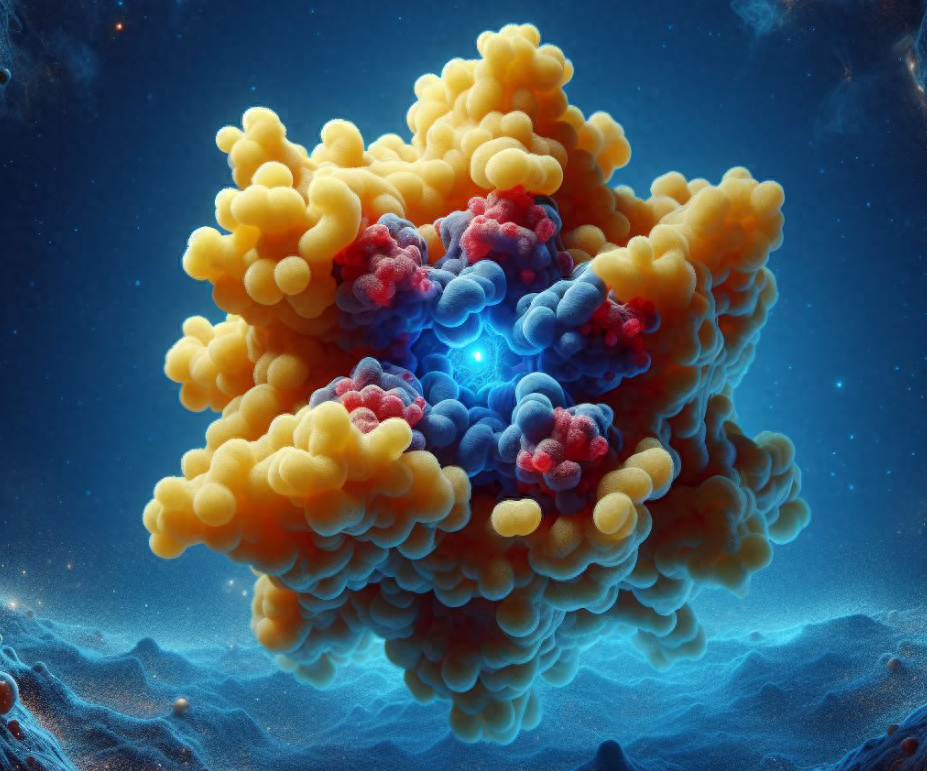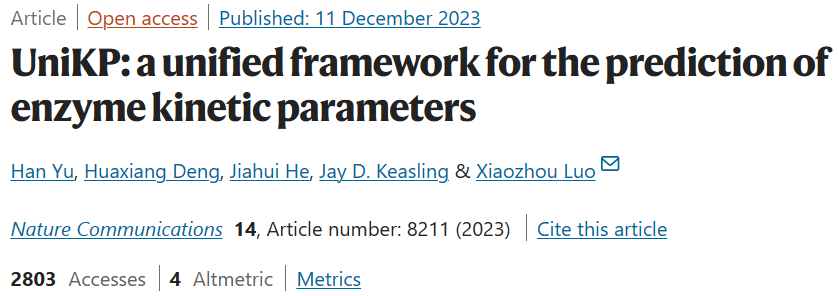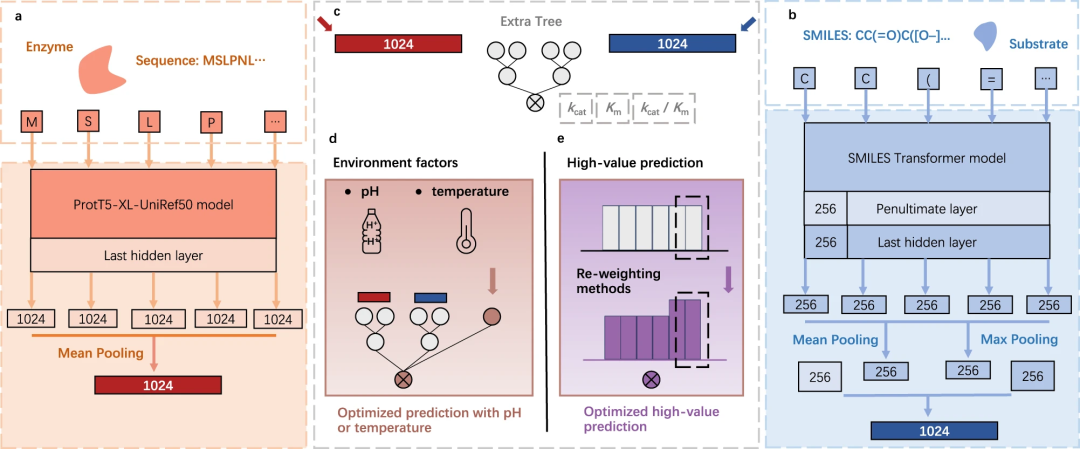 Technology peripherals
Technology peripherals
 AI
AI
 Chinese Academy of Sciences team creates a unified framework for improving prediction accuracy of enzyme kinetic parameters
Chinese Academy of Sciences team creates a unified framework for improving prediction accuracy of enzyme kinetic parameters
Chinese Academy of Sciences team creates a unified framework for improving prediction accuracy of enzyme kinetic parameters

Editor | Radish Skin
Prediction of enzyme kinetic parameters is crucial for the design and optimization of enzymes in biotechnology and industrial applications. However, current prediction tools are Limited performance on various tasks limits their practical applications.
Researchers from the Chinese Academy of Sciences recently proposed UniKP, a unified framework based on pre-trained language models that can be used to predict enzyme kinetic parameters, including enzyme turnover number (kcat), Michaelis-Menten constant (Km) and catalytic efficiency (kcat/Km), these parameters were obtained from the protein sequence and substrate structure.
A two-layer framework based on UniKP (EF-UniKP) is also proposed, which is capable of stably predicting kcat values taking into account environmental factors such as pH and temperature. At the same time, the research team also systematically explored four representative reweighting methods, successfully reducing prediction errors in high-value prediction tasks.
The study is titled "UniKP: a unified framework for the prediction of enzyme kinetic parameters" and was published in the journal "Nature Communications" on December 11, 2023.

Studying the catalytic efficiency of enzymes towards specific substrates is an important issue in biology and has a profound impact on enzyme evolution, metabolic engineering and synthetic biology. In vitro experimental data measuring kcat and Km, as well as the maximum turnover rate and Michaelis-Menten constant, can be used as indicators to measure the efficiency of enzymes in catalyzing specific reactions and to compare the relative catalytic activities of different enzymes.
At present, the measurement of enzyme kinetic parameters mainly relies on experimental measurement, which is time-consuming, costly and labor-intensive, resulting in a small database of experimentally measured kinetic parameter values. For example, the sequence database UniProt contains over 230 million enzyme sequences, while the enzyme databases BRENDA and SABIO-RK contain tens of thousands of experimentally measured kcat values. The integration of Uniprot identifiers in these enzyme databases facilitates the connection between measured parameters and protein sequences. However, the scale of these connections is still much smaller compared to the number of enzyme sequences, limiting progress in downstream applications such as directed evolution and metabolic engineering.
Enzyme kinetic parameter prediction framework
In this study, researchers from the Chinese Academy of Sciences proposed a new framework called UniKP, which is based on pre-training Language model designed to improve the accuracy of predicting enzyme kinetic parameters. These parameters include kcat, Km and kcat/Km, which can be predicted given the enzyme sequence and substrate structure. The researchers conducted a comprehensive comparison of 16 different machine learning models and 2 deep learning models and found that UniKP performed well in terms of prediction accuracy. This research is expected to provide new tools and methods for research and applications in the field of enzyme kinetics.

Illustration: UniKP overview. (Source: paper)
Compared with the previous state-of-the-art model DLKcat, UniKP shows superior performance in the kcat prediction task, with an average coefficient of determination of 0.68, an improvement of 20%. The researchers speculate that the pretrained models contributed significantly to UniKP's performance by using unsupervised information from the entire database to create easy-to-learn representations of enzyme sequences and substrate structures.
Analysis of model learning showed that protein information has a dominant role, possibly due to the complexity of the enzyme structure compared to the substrate structure. Furthermore, UniKP can effectively capture small differences in kcat values between enzymes and their mutants, including experimentally measured cases, which is crucial for enzyme design and modification. The difference between the R^2 of UniKP predictions and the R^2 of the gmean method for high- and low-identity regions demonstrates UniKP's ability to extract deeper interconnected information and thus perform well in these tasks. Higher forecast accuracy.
Two-layer framework EF-UniKP
Most current models do not consider environmental factors, which is a key limitation in simulating real experimental conditions. To solve this problem, the researchers proposed a two-layer framework EF-UniKP, which takes environmental factors into account. Based on two newly constructed datasets with pH and temperature information respectively, EF-UniKP shows improved performance compared to the initial UniKP. This is an accurate, high-throughput, organism-independent and context-dependent kcat prediction. Additionally, this approach has the potential to be expanded to include other factors such as co-substrate and NaCl concentration.

Illustration: Two-layer framework considering environmental factors. (Source: paper)
However, existing models do not consider the interaction between these factors due to a lack of comprehensive data. As experimental techniques advance, including biocast laboratory automation and continuous evolution methods, researchers anticipate a proliferation of enzyme kinetic data. This influx has not only enriched the field but also improved the accuracy of predictive models.
Due to the high imbalance of the kcat dataset, resulting in higher errors in high kcat value predictions, the team systematically explored four representative reweighting methods to alleviate this problem. The results show that the hyperparameter settings of each method are critical to improving high kcat value predictions.
The team confirmed the strong generality of the current framework in terms of Michaelis constant (Km) prediction and kcat/Km prediction. UniKP achieves state-of-the-art performance in predicting Km values and, more impressively, outperforms the combined results of current state-of-the-art models in predicting kcat/Km values. Furthermore, the researchers validated the UniKP framework based on experimentally measured kcat/Km values and kcat/Km values calculated using kcat and Km prediction models on the kcat/Km dataset.
It is worth noting that the correlation observed between the values derived from UniKP kcat / UniKP Km and the experimental kcat / Km is relatively low (PCC = −0.01). This difference may be due to the different data sets used in building the respective models, thus requiring the development of a different model to predict kcat/Km values. In the future, with the emergence of unified data sets containing kcat and Km values, it is expected that the computational output of the kcat and Km models will be closely consistent with the output generated by the kcat/Km dedicated model.
Specific application in enzyme mining and evolution
The application of UniKP in the mining and directed evolution of tyrosine ammonia lyase (TAL) enzyme has demonstrated its ability to revolutionize synthetic biology and potential for biochemical research. This study shows that UniKP effectively recognizes highly active TALs and rapidly improves the catalytic efficiency of existing TALs, with RgTAL-489T having a kcat/Km value 3.5 times higher than that of the wild-type enzyme.
Furthermore, the derived framework EF-UniKP was always able to identify highly active TAL enzymes with extremely high accuracy, with kcat/Km values 2.6-fold higher for TrTAL from Tephrocybe rancida than the wild-type enzyme. The results showed that the kcat and kcat/Km values of the five sequences exceeded those of the wild-type enzyme.
By accelerating the enzyme discovery and optimization process, UniKP is expected to become a powerful tool for advancing biocatalysis, drug discovery, metabolic engineering and other fields that rely on enzyme-catalyzed processes.
Limitations and Outlook
However, the current version of UniKP still has some limitations. For example, while UniKP is able to differentiate between experimentally measured kcat values of an enzyme and its variants, the predicted kcat values are not accurate enough. This may be due to insufficient data sets compared to the number of known protein sequences and substrate structures.
While the reweighting method can alleviate the prediction bias caused by the unbalanced kcat dataset to a certain extent (about 6.5% improvement), more can be achieved through synthetic minority oversampling techniques and other sample synthesis methods. Significant improvement.
A central goal of synthetic biology is the development of digital cells that will revolutionize the way scientists study biology. A key prerequisite for this study is the careful determination of enzymatic parameters for all enzymes within the pathway. Artificial intelligence-assisted tools shed light on this challenge, providing a high-throughput method for predicting enzyme kinetics.
Although the UniKP predictor error is reduced compared to earlier models, inaccuracy remains a significant obstacle to building accurate metabolic models. Incorporating an increasing number of experimentally determined kcat and Km values can improve model accuracy.
Next, the researchers plan to combine state-of-the-art algorithms such as transfer learning, reinforcement learning, and other small-shot learning algorithms to effectively handle imbalanced data sets. And, the team aims to explore additional applications, including enzyme evolution and global analysis of organisms.
Paper link: https://www.nature.com/articles/s41467-023-44113-1
The above is the detailed content of Chinese Academy of Sciences team creates a unified framework for improving prediction accuracy of enzyme kinetic parameters. For more information, please follow other related articles on the PHP Chinese website!

Hot AI Tools

Undresser.AI Undress
AI-powered app for creating realistic nude photos

AI Clothes Remover
Online AI tool for removing clothes from photos.

Undress AI Tool
Undress images for free

Clothoff.io
AI clothes remover

Video Face Swap
Swap faces in any video effortlessly with our completely free AI face swap tool!

Hot Article

Hot Tools

Notepad++7.3.1
Easy-to-use and free code editor

SublimeText3 Chinese version
Chinese version, very easy to use

Zend Studio 13.0.1
Powerful PHP integrated development environment

Dreamweaver CS6
Visual web development tools

SublimeText3 Mac version
God-level code editing software (SublimeText3)

Hot Topics
 1389
1389
 52
52
 Breaking through the boundaries of traditional defect detection, 'Defect Spectrum' achieves ultra-high-precision and rich semantic industrial defect detection for the first time.
Jul 26, 2024 pm 05:38 PM
Breaking through the boundaries of traditional defect detection, 'Defect Spectrum' achieves ultra-high-precision and rich semantic industrial defect detection for the first time.
Jul 26, 2024 pm 05:38 PM
In modern manufacturing, accurate defect detection is not only the key to ensuring product quality, but also the core of improving production efficiency. However, existing defect detection datasets often lack the accuracy and semantic richness required for practical applications, resulting in models unable to identify specific defect categories or locations. In order to solve this problem, a top research team composed of Hong Kong University of Science and Technology Guangzhou and Simou Technology innovatively developed the "DefectSpectrum" data set, which provides detailed and semantically rich large-scale annotation of industrial defects. As shown in Table 1, compared with other industrial data sets, the "DefectSpectrum" data set provides the most defect annotations (5438 defect samples) and the most detailed defect classification (125 defect categories
 NVIDIA dialogue model ChatQA has evolved to version 2.0, with the context length mentioned at 128K
Jul 26, 2024 am 08:40 AM
NVIDIA dialogue model ChatQA has evolved to version 2.0, with the context length mentioned at 128K
Jul 26, 2024 am 08:40 AM
The open LLM community is an era when a hundred flowers bloom and compete. You can see Llama-3-70B-Instruct, QWen2-72B-Instruct, Nemotron-4-340B-Instruct, Mixtral-8x22BInstruct-v0.1 and many other excellent performers. Model. However, compared with proprietary large models represented by GPT-4-Turbo, open models still have significant gaps in many fields. In addition to general models, some open models that specialize in key areas have been developed, such as DeepSeek-Coder-V2 for programming and mathematics, and InternVL for visual-language tasks.
 Training with millions of crystal data to solve the crystallographic phase problem, the deep learning method PhAI is published in Science
Aug 08, 2024 pm 09:22 PM
Training with millions of crystal data to solve the crystallographic phase problem, the deep learning method PhAI is published in Science
Aug 08, 2024 pm 09:22 PM
Editor |KX To this day, the structural detail and precision determined by crystallography, from simple metals to large membrane proteins, are unmatched by any other method. However, the biggest challenge, the so-called phase problem, remains retrieving phase information from experimentally determined amplitudes. Researchers at the University of Copenhagen in Denmark have developed a deep learning method called PhAI to solve crystal phase problems. A deep learning neural network trained using millions of artificial crystal structures and their corresponding synthetic diffraction data can generate accurate electron density maps. The study shows that this deep learning-based ab initio structural solution method can solve the phase problem at a resolution of only 2 Angstroms, which is equivalent to only 10% to 20% of the data available at atomic resolution, while traditional ab initio Calculation
 Google AI won the IMO Mathematical Olympiad silver medal, the mathematical reasoning model AlphaProof was launched, and reinforcement learning is so back
Jul 26, 2024 pm 02:40 PM
Google AI won the IMO Mathematical Olympiad silver medal, the mathematical reasoning model AlphaProof was launched, and reinforcement learning is so back
Jul 26, 2024 pm 02:40 PM
For AI, Mathematical Olympiad is no longer a problem. On Thursday, Google DeepMind's artificial intelligence completed a feat: using AI to solve the real question of this year's International Mathematical Olympiad IMO, and it was just one step away from winning the gold medal. The IMO competition that just ended last week had six questions involving algebra, combinatorics, geometry and number theory. The hybrid AI system proposed by Google got four questions right and scored 28 points, reaching the silver medal level. Earlier this month, UCLA tenured professor Terence Tao had just promoted the AI Mathematical Olympiad (AIMO Progress Award) with a million-dollar prize. Unexpectedly, the level of AI problem solving had improved to this level before July. Do the questions simultaneously on IMO. The most difficult thing to do correctly is IMO, which has the longest history, the largest scale, and the most negative
 Nature's point of view: The testing of artificial intelligence in medicine is in chaos. What should be done?
Aug 22, 2024 pm 04:37 PM
Nature's point of view: The testing of artificial intelligence in medicine is in chaos. What should be done?
Aug 22, 2024 pm 04:37 PM
Editor | ScienceAI Based on limited clinical data, hundreds of medical algorithms have been approved. Scientists are debating who should test the tools and how best to do so. Devin Singh witnessed a pediatric patient in the emergency room suffer cardiac arrest while waiting for treatment for a long time, which prompted him to explore the application of AI to shorten wait times. Using triage data from SickKids emergency rooms, Singh and colleagues built a series of AI models that provide potential diagnoses and recommend tests. One study showed that these models can speed up doctor visits by 22.3%, speeding up the processing of results by nearly 3 hours per patient requiring a medical test. However, the success of artificial intelligence algorithms in research only verifies this
 To provide a new scientific and complex question answering benchmark and evaluation system for large models, UNSW, Argonne, University of Chicago and other institutions jointly launched the SciQAG framework
Jul 25, 2024 am 06:42 AM
To provide a new scientific and complex question answering benchmark and evaluation system for large models, UNSW, Argonne, University of Chicago and other institutions jointly launched the SciQAG framework
Jul 25, 2024 am 06:42 AM
Editor |ScienceAI Question Answering (QA) data set plays a vital role in promoting natural language processing (NLP) research. High-quality QA data sets can not only be used to fine-tune models, but also effectively evaluate the capabilities of large language models (LLM), especially the ability to understand and reason about scientific knowledge. Although there are currently many scientific QA data sets covering medicine, chemistry, biology and other fields, these data sets still have some shortcomings. First, the data form is relatively simple, most of which are multiple-choice questions. They are easy to evaluate, but limit the model's answer selection range and cannot fully test the model's ability to answer scientific questions. In contrast, open-ended Q&A
 PRO | Why are large models based on MoE more worthy of attention?
Aug 07, 2024 pm 07:08 PM
PRO | Why are large models based on MoE more worthy of attention?
Aug 07, 2024 pm 07:08 PM
In 2023, almost every field of AI is evolving at an unprecedented speed. At the same time, AI is constantly pushing the technological boundaries of key tracks such as embodied intelligence and autonomous driving. Under the multi-modal trend, will the situation of Transformer as the mainstream architecture of AI large models be shaken? Why has exploring large models based on MoE (Mixed of Experts) architecture become a new trend in the industry? Can Large Vision Models (LVM) become a new breakthrough in general vision? ...From the 2023 PRO member newsletter of this site released in the past six months, we have selected 10 special interpretations that provide in-depth analysis of technological trends and industrial changes in the above fields to help you achieve your goals in the new year. be prepared. This interpretation comes from Week50 2023
 The accuracy rate reaches 60.8%. Zhejiang University's chemical retrosynthesis prediction model based on Transformer was published in the Nature sub-journal
Aug 06, 2024 pm 07:34 PM
The accuracy rate reaches 60.8%. Zhejiang University's chemical retrosynthesis prediction model based on Transformer was published in the Nature sub-journal
Aug 06, 2024 pm 07:34 PM
Editor | KX Retrosynthesis is a critical task in drug discovery and organic synthesis, and AI is increasingly used to speed up the process. Existing AI methods have unsatisfactory performance and limited diversity. In practice, chemical reactions often cause local molecular changes, with considerable overlap between reactants and products. Inspired by this, Hou Tingjun's team at Zhejiang University proposed to redefine single-step retrosynthetic prediction as a molecular string editing task, iteratively refining the target molecular string to generate precursor compounds. And an editing-based retrosynthetic model EditRetro is proposed, which can achieve high-quality and diverse predictions. Extensive experiments show that the model achieves excellent performance on the standard benchmark data set USPTO-50 K, with a top-1 accuracy of 60.8%.



